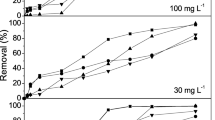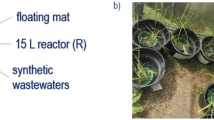Abstract
The aim of this work was to study the influence of nutrients on the tolerance, removal efficiency and accumulation of high concentration of Cr(III) by Typha domingensis. This species was exposed to the following Cr(III) treatments, arranged in triplicate: 200 mg L−1 Cr; 600 mg L−1 Cr; 200 mg L−1 Cr + 50 mg L−1 P + 50 mg L−1 N; 600 mg L−1 Cr + 50 mg L−1 P + 50 mg L−1 N; without metal or nutrient additions (control 1); 50 mg L−1 P + 50 mg L−1 N, without metal addition (control 2). In order to simulate extreme events, the concentrations studied were higher than the concentrations commonly found in constructed wetlands. Cr and nutrient concentrations in water decreased in all treatments along time. Nutrient addition did not affect Cr removal for the two concentrations studied. In tissues, the highest Cr concentrations were observed in roots in all treatments. The mass balance showed that sediment showed the highest accumulation of Cr. Metals caused growth inhibition and a decrease in chlorophyll concentration. Despite these sublethal effects, T. domingensis demonstrated that it could accumulate Cr. These results confirm the high tolerance of this species ensuring the survival plant and wetland efficiency in time.





Similar content being viewed by others
References
Abdel-Basset R, Issa AA, Adam MS (1995) Chlorophyllase activity: effect of heavy metals and calcium. Photosynthetica 31:421–425
APHA (1998) Standard methods for the examination of water and wastewater. American Public Health Association, New York
Barko JW, Gunnison D, Carpenter SR (1991) Sediment interactions with submersed macrophyte growth and community dynamics. Aquat Bot 41:41–65
Bishop P, Eighmy T (1989) Aquatic wastewater treatment using Elodea nutallii. J Water Pollut Control Fed 61(5):641–648
Bonilla I (2008) Introducción a la nutrición mineral de las plantas. Los elementos minerales. In: Azcón-Bieto J, Talón M (eds) Fundamentos de Fisiología Vegetal. Mc Graw Hill-UBe, New York, pp 103–121
Britto DT, Kronzucker HJ (2002) NH4 toxicity in higher plants: a critical review. J Plant Physiol 159:567–584
Brix H, Schierup HH (1990) Soil oxygenation in constructed reed beds: the role of macrophyte and soil atmosphere interface oxygen transport. In: Cooper P, Findlater B (eds) Constructed wetlands in water pollution control. WRc Swindon, Wiltshire, pp 53–65
Chandra H, Kulshreshtha K (2004) Chromium accumulation and toxicyti in aquatic vascular plants. Bot Rev 70(3):313–327
Chandra R, Yadav S (2010) Potential of Typha angustifolia for phytoremediation of heavy metals from aqueous solution of phenol and melanoidin. Ecol Eng 36:1277–1284
Chaney R (1993) Zinc phytotoxicity. In: Robson A (ed) Zinc in soils and plants. Kluwer, Dordercht, pp 135–150
Chen CJ, Wang KS, Chen H, Lu ChY, Huang LCh, Li HCh, Peng TH, Chang SH (2010) Phytoremediation of Cr(III) by Ipomonea aquatica (water spinach) from water in the presence of EDTA and chloride: effects of Cr speciation. Bioresour Technol 101:3033–3039
Clothier B, Green S (1997) Roots: the big movers of water and chemical in soil. Soil Sci 162:534–543
Dekock PC (1956) Heavy metal toxicity and iron chlorosis. Ann Bot 20:133–141
Delgado M, Bigeriego M, Guardiola E (1993) Uptake of Zn, Cr and Cr by water Hyacinths. Water Res 27(2):269–270
Di Luca GA, Mufarrege MM, Sánchez GC, Hadad HR, Maine MA (2011) P distribution in different sediment fraction of a constructed wetland. Water Sci Technol 63(10):2374–2380
Di Luca GA, Hadad HR, Mufarrege MM, Maine MA, Sánchez GC (2013) Improvement of Cr phytoremediation by Pistia stratiotes in presence of nutrients. Int J Phytoremediation 16(2):167–178
Fendorf S (1995) Surface reactions of chromium in soils and waters. Geoderma 67:55–71
Göthberg A, Greger M, Holm K, Bengtsson BE (2004) Influence of nutrient levels on uptake and effects of mercury, cadmium and lead in water spinach. J Environ Qual 33:1247
Hadad HR, Maine MA, Natale GS, Bonetto CA (2007) The effect of nutrient addition on metal tolerance in Salvinia herzogii. Ecol Eng 31:122–131
Hadad HR, Maine MA, Mufarrege MM, del Sastre MV, Di Luca GA (2011) Bioaccumulation kinetics and toxic effects of Cr, Ni and Zn on Eichhornia crassipes. J Hazard Mater 190:1016–1022
Hammer DA, Bastion RK (1989) Wetlands ecosystems: natural water purifiers? In: Hammer DA (ed) Constructed wetlands for wastewater treatment. Lewis publishers, Chelsea, pp 5–20
Hardej M, Ozimek T (2002) The effect of sewage sludge flooding on growth and morphometric parameters of Phragmites australis (Cav.) Trin. ex Steudel. Ecol Eng 18:343–350
Hechmi N, Aissa NB, Abdenaceur H, Jedidi N (2014) Evaluating the phytoremediation potential of Phragmites australis grown in pentachlorophenol and cadmium co-contaminated soils. Environ Sci Pollut Res 21(2):1304–1313
Hegazy AK, Adbel Ghani NT, El-Chaghaby GA (2011) Phytoremediation of industrial wastewater potentiality by Typha domingensis. Int J Environ Sci Technol 8(3):639–648
Heumann HG (1987) Effects of heavy metals on growth and ultrastucture of Chara vulgar. Protoplasma 136:37–48
Hunt R (1978) Studies in biology Nº 96. Edward Arnold Ltd., London, pp 12–16
Hunter JG, Vergnano O (1953) Trace element toxicities in oat plants. Ann Appl Biol 40:761–777
Jacob D, Otte M (2003) Conflicting processes in the wetland plant rhizosphere: metal retention or mobilization? Water Air Soil Pollut 3:91–104
Jampeetong A, Brix H (2009) Effects of NH4 concentration on growth, morphology and NH4 uptake kinetics of Salvinia natans. Ecol Eng 35:695–702
Kabata-Pendias A, Pendias H (2011) Trace elements in soils and plants. CRC Press, Florida
Kadlec RH, Knight RL (1996) Treatment wetlands. Lewis Publishers, Boca Raton
Kadlec RH, Wallace SD (2009) Treatment wetlands, 2nd edn. CRC Press, Boca Raton
Larsen VJ, Schierup HH (1981) Macrophyte cycling of zinc, copper, lead and cadmium in the littoral zone of a polluted and a non-polluted lake. II. Seasonal changes in heavy metal content of aboveground biomass and decomposing leaves of Phragmites australis (Cav.) Trin. Aquat Bot 11:211–230
Loneragan J, Weeb M (1993) Interactions between Zinc and other nutrients affecting the growth of plants. In: Robson A (ed) Zinc in soils and plants. Kluwer, Dordercht, pp 119–131
Lyon GL, Peterson PJ, Brooks RR (1969) Chromium-51 distribution in tissues and extracts of Leptospermum scoparium. Planta 88:282–287
Maine MA, Duarte M, Suñe N (2001) Cadmium uptake by floating macrophytes. Water Res 35:2629–2634
Maine MA, Suñé NL, Lagger SC (2004) Chromium bioaccumulation: comparison of the capacity of two floating aquatic macrophytes. Water Res 38:1494–1501
Maine MA, Suñe N, Hadad H, Sánchez G, Bonetto C (2007) Removal efficiency of a constructed wetland for wastewater treatment according to vegetation dominance. Chemosphere 68:1105–1113
Maine MA, Suñé N, Hadad H, Sánchez G, Bonetto C (2009) Influence of vegetation on the removal of heavy metals and nutrients in a constructed wetland. J Environ Manag 90:355–363
Maine MA, Hadad HR, Sánchez GC, Mufarrege MM, Di Luca GA, Caffaratti SE, Pedro MC (2013) Sustainability of a constructed wetland faced with a depredation event. J Environ Manag 128:1–6
Mangabeira PA, Ferreira AS, de Almeida AAF, Fernandes VF, Lucena E, Souza VL, dos Santos Júnior AJ, Oliveira AH, Grenier-Loustalot MF, Barbier F, Silva DC (2011) Compartmentalization and ultrastructural alterations induced by chromium in aquatic macrophytes. Biometals 24:1017–1026
Manios T, Stentiford E, Millner P (2003) The effect of heavy metals accumulation on the chlorophyll concentration of Typha latifolia plants, growing in a substrate containing sewage sludge compost and watered with metaliferus water. Ecol Eng 20:65–74
Mojiri A (2011) Phytoremediation of heavy metals from municipal wastewater by Typha domingensis. Afr J Microbiol Res 6(3):643–647
Mufarrege MM, Hadad HR, Maine MA (2010) Response of Pistia stratiotes to heavy metals (Cr, Ni, and Zn) and phosphorous. Arch Environ Contam Toxicol 58(1):53–61
Mufarrege MM, Hadad HR, Di Luca GA, Maine MM (2015) Typha domingensis ability to accumulate and tolerate high concentrations of Cr, Ni and Zn. Environ Sci Pollut Res 22:286–292
Murphy J, Riley J (1962) A modified single solution method for determination of phosphate in natural waters. Ann Chem Acta 27:31–36
Nilratnisakorn S, Thiravetyan P, Nakbanpote W (2007) Synthetic reactive dye wastewater treatment by narrow-leaved cattails (Typha angustifolia Linn.): effects of dye, salinity and metals. Sci Total Environ 384:67–76
Rebechini HM, Hanzely L (1974) Lead-induced ultrastructural changes in chloroplasts. Z. pflanzenphysiol Bd 73:377–386
Salt DE, Krämer U (2000) Mechanisms of metal hyperaccumulation in plants. In: Raskin I, Ensley BD (eds) Phytoremediation of toxic metals, using plants to clean up the environment. Wiley, New York, pp 231–246
Shanker AK, Cervantes C, Loza-Tavera H, Avudainayagam S (2005) Chromium toxicity in plants. Environ Int 31:739–753
Sinha S, Gupta AK (2005) Translocation of metals from fly ash amended soil in the plant of Sesbania cannabina L. Ritz: effect on antioxidants. Chemosphere 61:1204–1214
Skeffington RA, Cegrí PR, Peterson PJ (1976) Chromium uptake and transport in barley seedling (Hordeum vulgare L.). Planta 132:209–214
Song Z, Zheng Z, Li J, Sun X, Han X, Wang W, Xu M (2006) Seasonal and annual performance of a full-scale constructed wetland system for sewage treatment in China. Ecol Eng 26:272–282
Sorrell BK, Boon PL (1992) Biogeochemistry of billabong sediments. II Seasonal variations in methane production. Freshw Biol 27:435–445
Stoltz E, Greger M (2002) Accumulation properties of As, Cd, Cu, Pb and Zn by four wetland plant species growing on submerged mine tailings. Environ Exp Bot 47:271–280
Sundby B, Caetano M, Vale C, Gobeil C, Luther G, Nuzzio D (2005) Rootinduced cycling of lead in salt marsh sediments. Environ Sci Technol 39:2080–2086
Suñé N, Sánchez G, Caffaratti S, Maine MA (2007) Cadmium and chromium removal kinetics from solution by two aquatic macrophytes. Environ Poll 145(2):467–473
Taylor GJ, Crowder AA (1983) Uptake and accumulation of copper, nickel, and iron by Typha latifolia grown in solution culture. Can J Bot 61:1825–1830
Tiffin LO (1972) Translocation of micronutrients in plants. In: Mortvedt JJ, Giordano PW, Lindsay WL (eds). Micronutrients in agriculture. Soil Sci. Soc Am, Inc. p l99-229
Turner MA, Rust RH (1971) Effects of chromium on growth and mineral nutrition of soybeans. Soil Sci Soc Am Proc 35:755–758
Tylova E, Steinbachova L, Votrubova O, Lorenzen B, Brix H (2008) Different sensitivity of Phragmites australis and Glyceria maxima to high availability of ammonium-N. Aquat Bot 88:93–98
Vymazal J (2011) Constructed wetlands for wastewater treatment: five decades of experience. Environ Sci Technol 45:61–69
Vymazal J, Kröpfelová L (2008) Wastewater treatment in constructed wetlands with horizontal sub-surface flow. Springer, Dordrecht
Westlake DF (1974) Macrophytes. In: Vollenweider RA (ed) A manual on methods for measuring primary production in aquatic environments, IBP Handbook No 12, 2nd edn. Blackwell Scientific Publications, Oxford, International Biological Programme, pp 32–42
Zhou KY, Chen SS, Li MQ (1993) Effect of different levels of phosphorus nutrition on the photosynthesis and respiration tobacco leaf. Acta Phytophysiol Sin 19(1):3–8
Acknowledgments
The authors thank Consejo Nacional de Investigaciones Científicas y Técnicas (CONICET), Universidad Nacional del Litoral (UNL)-CAI+D Project and Agencia de Promoción Científica y Tecnológica for providing funds for this work.
Author information
Authors and Affiliations
Corresponding author
Additional information
This article is part of a Topical Collection in Environmental Earth Sciences on “3RAGSU,” guest edited by Daniel Emilio Martinez.
Rights and permissions
About this article
Cite this article
Mufarrege, M.M., Di Luca, G.A., Sanchez, G.C. et al. Effects of the presence of nutrients in the removal of high concentrations of Cr(III) by Typha domingensis . Environ Earth Sci 75, 887 (2016). https://doi.org/10.1007/s12665-016-5693-3
Received:
Accepted:
Published:
DOI: https://doi.org/10.1007/s12665-016-5693-3




